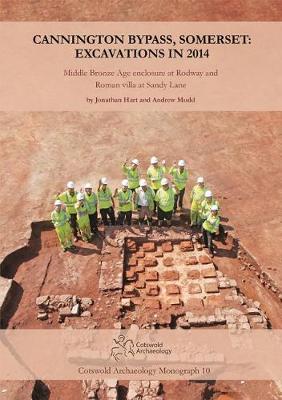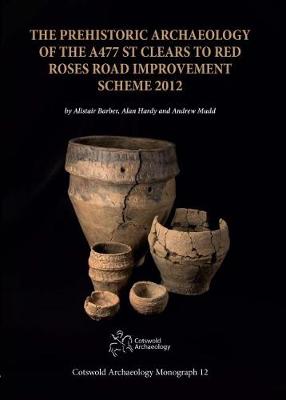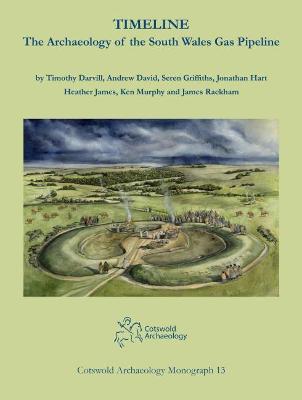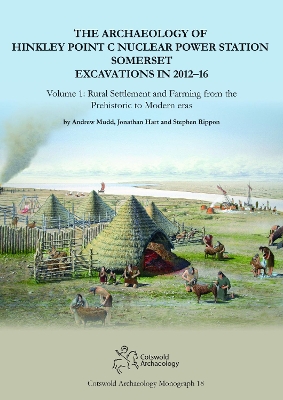Cotswold Archaeology Monograph
7 primary works
Book 9
Living Near the Edge
by Andrew Mudd, E.R. McSloy, Mark Brett, and Jonathan Hart
Published 31 March 2016
Archaeological surveys and excavations were carried out between 2006 and 2010 in advance of the construction of a gas pipeline in the Gloucestershire Cotswolds. They resulted in the discovery of many new sites and the investigation of eighteen of them dating from the prehistoric to medieval periods.
Early Neolithic and Beaker/Early Bronze Age pits in the southern part of the route near Winstone, suggest transitory occupation in early prehistoric times. Early Bronze Age cremation graves on lower ground near Stanway were associated with two slightly later ring-ditches, and another Bronze Age ring-ditch was excavated at Foxcote Hill. A segmented boundary ditch near Winstone was also the location of Iron Age and Roman activity. An Iron Age settlement on Salter’s Hill, Winchcombe, included an Early Iron Age roundhouse, while Middle Iron Age grain-storage pits here and elsewhere indicated other farming settlements. Late Iron Age and Roman occupations in the high Wolds showed a range of remains, including unusual deposits of artefacts, animal bones and burials.
A fragmentary sequence of Anglo-Saxon boundary burials was found at the southern end of the route near Sapperton. In the same area, two 12th- to 13th-century buildings near Overley Wood may have been part of the medieval settlement of Pinbury. Trackways revealed near Coberley, Foxcote and Hailes linked rural settlements in historical times.
The range of sites and finds from these investigations provide important new information on the human past across parts of a landscape in many respects considered to be marginal.
Early Neolithic and Beaker/Early Bronze Age pits in the southern part of the route near Winstone, suggest transitory occupation in early prehistoric times. Early Bronze Age cremation graves on lower ground near Stanway were associated with two slightly later ring-ditches, and another Bronze Age ring-ditch was excavated at Foxcote Hill. A segmented boundary ditch near Winstone was also the location of Iron Age and Roman activity. An Iron Age settlement on Salter’s Hill, Winchcombe, included an Early Iron Age roundhouse, while Middle Iron Age grain-storage pits here and elsewhere indicated other farming settlements. Late Iron Age and Roman occupations in the high Wolds showed a range of remains, including unusual deposits of artefacts, animal bones and burials.
A fragmentary sequence of Anglo-Saxon boundary burials was found at the southern end of the route near Sapperton. In the same area, two 12th- to 13th-century buildings near Overley Wood may have been part of the medieval settlement of Pinbury. Trackways revealed near Coberley, Foxcote and Hailes linked rural settlements in historical times.
The range of sites and finds from these investigations provide important new information on the human past across parts of a landscape in many respects considered to be marginal.
Book 10
Cannington Bypass, Somerset: Excavations in 2014
by Jonathan Hart and Andrew Mudd
Published 15 December 2018
Two enclosures were recorded – near Rodway was discovered a small Middle Bronze Age farmstead containing evidence of two roundhouses, with associated pottery and plant remains; and at Sandy Lane a Roman villa was shown to have developed from a Late Iron Age ridge-top settlement.
Book 12
The Prehistoric Archaeology of the A477 St Clears to Red Roses Road Improvement Scheme 2012
by Alistair Barber, Alan Hardy, and Andrew Mudd
Published 27 February 2019
Details results of excavations along the A477 from St Clears to Red Roses during the Road Improvement Scheme, 2012. Finds include a Mesolithic site in the lower Tâf valley; early Neolithic pits and a post-built structure at Cildywyll; the remains of an Early Bronze Age barrow, 38 burials (some urned), a pyre site, and a Middle Bronze Age drying oven near St Clears; and A Bronze Age burnt mound near Red Roses.
Book 13
Timeline. The Archaeology of the South Wales Gas Pipeline
by Timothy Darvill, Andrew David, Seren Griffiths, Jonathan Hart, Heather James, and James Rackham
Published 5 April 2021
The construction of a natural gas pipeline across southern Wales and into Herefordshire and Gloucestershire between 2005 and 2007 resulted in numerous archaeological discoveries, including sites of national significance. The project not only produced a wealth of new archaeological sites, it also generated important radiocarbon and environmental datasets for the region.
The earliest activity is indicated by worked flint of Mesolithic (or earlier) date, with the earliest Neolithic communities represented by pits, evidence for occasional timber houses, and the discovery of a previously unknown henge. Beaker and Bronze Age settlement and burial remains were found too, including a rare copper halberd. The excavations also produced evidence for Early Bronze Age houses and numerous examples of burnt mounds.
Other discoveries comprised much new evidence for Iron Age settlement (including some in areas of upland), Roman roads, crop-processing ovens, and ironworking. Rare evidence for the early medieval period was also found, along with the remains of later farmsteads and field systems. Moves towards industrialisation were reflected in the discovery of a brick kiln and charcoal-burning platforms.
The earliest activity is indicated by worked flint of Mesolithic (or earlier) date, with the earliest Neolithic communities represented by pits, evidence for occasional timber houses, and the discovery of a previously unknown henge. Beaker and Bronze Age settlement and burial remains were found too, including a rare copper halberd. The excavations also produced evidence for Early Bronze Age houses and numerous examples of burnt mounds.
Other discoveries comprised much new evidence for Iron Age settlement (including some in areas of upland), Roman roads, crop-processing ovens, and ironworking. Rare evidence for the early medieval period was also found, along with the remains of later farmsteads and field systems. Moves towards industrialisation were reflected in the discovery of a brick kiln and charcoal-burning platforms.
Book 15
Evolution of a Romano-British Courtyard Villa
by Tom Brindle, Mark Brett, and Jonathan Hart
Published 4 September 2023
Excavations between 2016–2018 revealed a series of structures that were re-organised and rebuilt over time, which culminated in a stone-built winged corridor villa in the mid to late 4th century AD. Wings were added to the buildings and a portico at the front opened out onto a courtyard. The outer courtyard was flanked by ancillary buildings, one of which contained a hypocaust and another a small bath suite. Finds included a rare copper alloy figurative lamp with probable foreign origins, a lion mask and a range of pottery, glass worked stone and bone. Environmental remains indicate a mixed arable and pastoral agricultural economy that supported its inhabitants and may have produced a surplus. Wood for fuel and other purposes was obtained from surrounding hedges and copses.
Book 17
The A120 Bypass and Flood Alleviation Scheme Little Hadham, Hertfordshire Archaeological Investigations 2019–2020
by Jo Barker, Sarah Cobain, and Mark Brett
Published 28 February 2024
A few scatters of Mesolithic and Neolithic flint were found across the development area. Slightly more extensive evidence for Neolithic occupation was represented by a small number of pits from which flint-tempered Neolithic pottery, worked flint, charred plant remains and animal bone were recovered. During the later Bronze Age and Iron Age the first permanent settlements were established. They were characterized by post-built circular structures, pits and cremation burials. Settlement began in the river valley and the western edge of the clay plateau but during the Iron Age settlement shifted onto the clay plateau with eh creation of a five-sided enclosure. By the Late Iron Age and Roman period a farmstead and managed fields were established. This farmstead has been defined as a complex-type farmstead and seems to have been involved in the large-scale production of spelt. Limited evidence was identified for Saxon activity but a few features, including the remains of a tree-lined avenue, may have been associated with the 17th century Hadham and Wickham Halls which were owned by the Capel family. This volume describes the archaeological remains as well as the artefacts and ecofactual material recovered from the excavations.
Book 18
The Archaeology of Hinkley Point C Nuclear Power Station, Somerset. Excavations in 2012-16
by Andrew Mudd, Jonathan Hart, and Stephen Rippon
Published 13 June 2024
Early Neolithic occupation (from about 3600 BC) was represented by small groups of pits which were partly contemporary with a well-known round barrow – a protected monument called Wick Barrow or Pixies’ Mound – lying just outside the development site. Later prehistoric remains included Bronze Age burnt mounds, boundary ditches, a Late Bronze Age enclosure, and an Early Iron Age midden. There was more widespread Late Iron Age and Roman settlement, including a seasonally occupied linear settlement with evidence of salt-making. Contemporary activity included a nearby late Roman settlement. On another site a sequence of occupation from the late Iron Age to modern eras was examined. Here historical documents add to the account of the site and preserved the names of some of the farm’s recent inhabitants.






